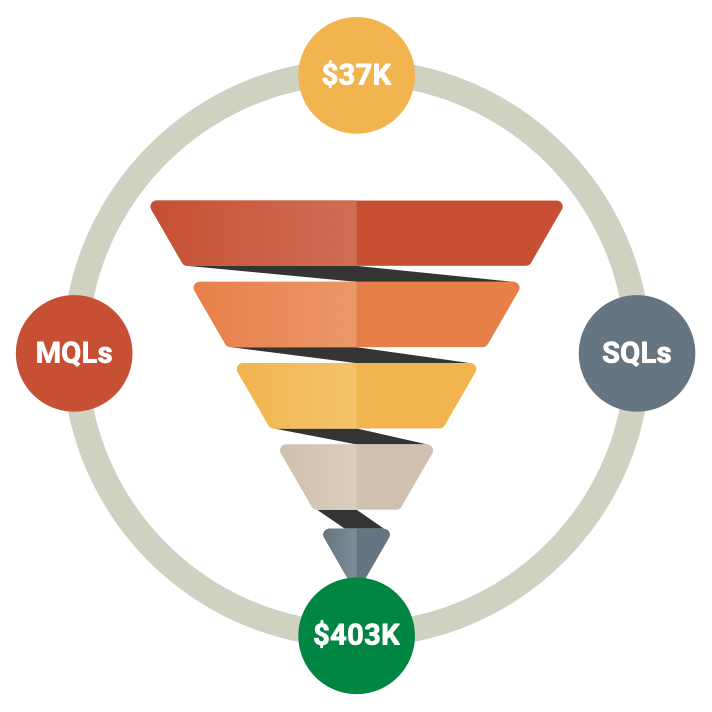ETL vs. ELT In Snowflake: What's the Difference?
The rate at which today’s organizations collect data is unprecedented. According to Statista, the amount of data created, shared, and stored is projected to reach 180 zettabytes by 2025.
Data availability is widespread, and the capacity to capture, format, and evaluate it promptly and accurately is a crucial driver for company success. Data-driven decision-making directs companies, and contextual data exposes new trends and patterns in the market that businesses can use to drive innovation.
But just as quickly as the sheer volume of data has expanded, so has the complexity of data itself.
Today’s data comes from more sources and formats than ever. As a result, structured data (e.g., names, dates, addresses), semi-structured data (e.g., email, HTML, JSON documents), and unstructured data (e.g., log files, videos, social media posts) must be managed and utilized to make better decisions faster.
Internal data sets like CRM or ERP systems are essential, but they’re not the only data sets that matter. Organizations must also account for social media data, Internet of Things (IoT) sensor data, clickstream data, and more. This volume and variety of data have given rise to a new set of challenges—and opportunities—for businesses across the globe.
Organizations are turning to the cloud to handle increased data volume, velocity, and variety. Cloud data warehouses (CDWs) like Snowflake provide the flexibility and scalability necessary to support a modern data strategy.
And to bring all of their disparate information to a single source of truth, organizations rely primarily on two approaches: extract, transform, load (ETL) and extract, load, transform (ELT).
But before we dive into ETL vs. ELT in Snowflake, let’s clearly define each process.
What Is Extract, Transform, Load (ETL)?
Extract, transform, load (ETL) is a process in data warehousing in which raw data is extracted from outside sources, transformed to fit operational needs (often using staging, cleansing, de-duping and merging techniques), then loaded into the end target database. ETL tools like Alteryx and Informatica offer a visual interface to help users design and automate the entire process.
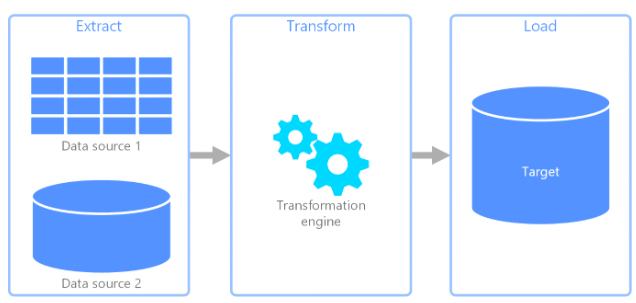
The ETL process typically follows this sequence:
- Extract data from homogeneous or heterogeneous data sources. This data can come from relational databases, flat files, XML, JSON, or Web services (e.g., SOAP or REST API).
- Transform the data. Data transformation includes selecting, filtering, sorting, aggregating, joins, normalization (for relational databases), and denormalization (for flat files).
- Load the transformed data into a destination database. This is usually a data warehouse or data mart. The loading process can include upserts (update or insert) and inserts.
Often, these three steps are performed in parallel because they can be quite resource-intensive.
Since data integration with ETL is a linear process, it is best suited for data transformations that are simple and well-defined such as relational data from onsite data warehouses. For larger or more complex data sets, ETL can be slow and cumbersome.
What Is Extract, Load, Transform (ELT)?
Extract, load, transform (ELT) is a modern data integration method that leverages the power of the cloud to make it easier and faster to get value from data.
The target data store’s processing capabilities are used to transform data rather than a separate transformation engine. This simplifies the architecture by removing the transformation engine from the pipeline.
Another advantage of this technique is that scaling the target data store improves the ELT process. However, ELT performs best when the target system has sufficient processing capacity to transform information properly.
ELT tools offer pre-built connectors that make it easy to set up a pipeline.
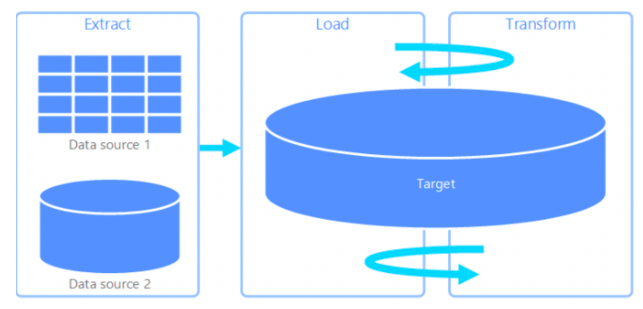
In general, ELT use cases are characterized by:
- Data from multiple heterogeneous sources
- Complex transformations
- The need for speed
A cloud-based data warehouse like Snowflake is the perfect platform for ELT because it is built for the cloud and offers a unique architecture that separates storage and computing. This separation allows data engineers to scale computing independently of storage, making it possible to quickly process large volumes of data. In addition, you only pay for the resources you use…gone are the days of capacity planning for the next 3-5 years.
So, What's the Difference Between ETL and ELT?
As their names imply, the main difference between ETL and ELT is when or where the transformation step occurs. The two key differences between the two processes are:
- In ETL, the transformation process happens before the data is loaded into the destination database. In ELT, data is first loaded into the destination database and then transformed.
- In ETL, raw data is transformed into an optimized format for the destination database. In ELT, the information is extracted and loaded into the destination database in its raw form. The transformation step happens after the data is loaded.
Let’s examine each process in detail.
Data Extraction
ETL: Raw data is extracted from multiple heterogeneous data sources using API calls or SQL queries. The data is then saved in flat files or staging tables.
ELT: Raw data is extracted from multiple heterogeneous data sources using API calls or SQL queries. The data is then loaded into the destination database.
Data Transformation
ETL: Data transformation includes cleansing, de-duping, filtering, and aggregation. The data is then transformed into the format required by the destination database. During transformation, you can add and remove specific columns.
ELT: The transformation step happens after the data is loaded into the destination database. Data transformation includes cleansing, de-duping, filtering, and aggregation. The data is then transformed into the format required by the destination database. Columns are directly added to the dataset with no modification support.
Data Loading
ETL: The transformed data is then loaded into the destination database. This can be done using bulk loaders or incremental loaders.
ELT: The raw data is loaded directly into the target system.
Speed of Implementation
ETL: ETL can be slow to implement because it is a linear process. Each data set must go through the extract, transform, and load steps before reaching the target database for analysis.
ELT: ELT is a faster process because it leverages the processing power of the target system. The data is loaded into the target first, then transformed in parallel.
Code-Based Data Transformation
ETL: Data is replicated and transformed on an intermediary server prior to being loaded into the target system.
ELT: Data is transformed after it has been replicated into the target system by taking advantage of the performance and scale of the data cloud. dbt is a market leading transformation tool used by data cloud organizations.
Data Security and Privacy
ETL: Transforming data before it’s loaded into the target system can remove PII and obfuscate data values.
ELT: Loading raw data allows special handling for sensitive data where data is tagged accordingly, allowing you to apply security and masking rules by role.
Transformation Output
ETL: ETL only loads data that is required for analytics or reporting, leaving other non-essential data behind in the source systems. It is typically structured data.
ELT: In the ELT process, all the extracted data is loaded at once. The output can be structured data, semi-structured data, or unstructured data.
Data Lake Compatibility
ETL: Not compatible with cloud data lakes due to its transformation step.
ELT: Compatible with cloud data lakes.
ETL vs. ELT: Pros and Cons
The Benefits of ETL
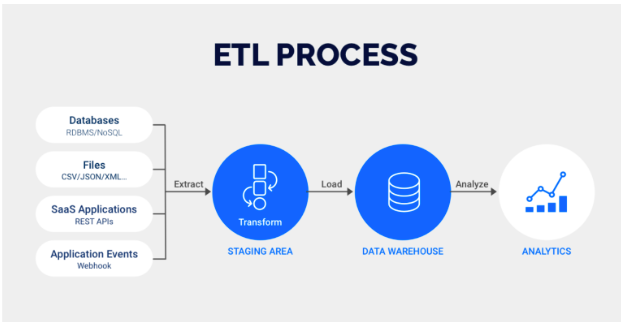
Although ETL is a process that has been around for decades, it is still the most popular data warehousing method. The main benefits of ETL are:
- Familiarity: The ETL process is well-known and has been used for a long time. There are also a lot more ETL tools available on the market.
- Support: Many tools are available to support ETL, including open source and commercial products.
- Faster Analysis: Although ETL can be slow to implement, it is faster when it comes to data analysis. As shown in the graphic above, the transformation step happens before the data is loaded into the target data warehouse, so the data is in a format that can be easily queried and analyzed.
- Compliance: When organizations need to comply with regulations such as GDPR, ETL enables them to encrypt sensitive data prior to loading it into the target system, ensuring data security and compliance.
The Drawbacks of ETL
Although familiar and predictable, ETL can have some drawbacks, including:
- Inflexibility: Because the transformation step happens before the data is loaded into the database, ETL can be rigid. The entire process needs to be updated if the data format or structure changes.
- Slow Loading and High Costs: Because the ETL process runs on separate servers, ETL can be a time-consuming and expensive process to set up and maintain.
- Lack of High-Volume Support: ETL best suits smaller data sets with relevant, in-depth data. It can struggle with large data sets or data that changes frequently.
- Maintenance Burden: The ETL process can be complex, making it difficult to maintain. If something goes wrong, troubleshooting and fixing the issue can be difficult.
The Benefits of ELT
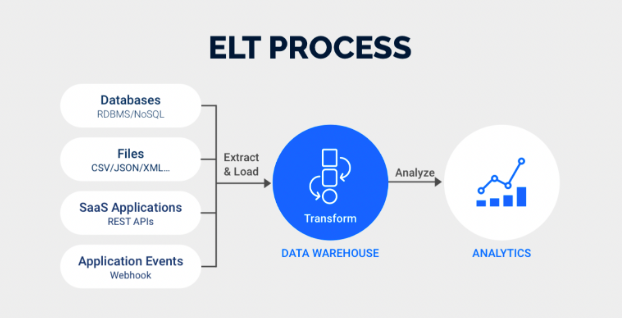
ELT has become increasingly popular in recent years as organizations look for ways to speed up their data warehousing processes. Many of its benefits build off of the drawbacks of ETL:
- Flexibility and Support for Many Data Formats: ELT can perform data ingestion in any format. Since the data lake accepts structured or unstructured data, there is no need to worry about schema changes.
- Scalability: ELT can scale to accommodate large data sets and high volumes of data, making it a scalable solution for data integration.
- As-Needed Transformation for Greater Resource Efficiency: ELT transforms data on-demand, only transforming it when needed. In the ETL process, data is converted before it is loaded into the target database, even if it is not needed for analytics or reporting.
- High Availability: All data is loaded into the data lake in the ELT process. This makes data available for transformation as soon as it is loaded, so tools that don’t have real-time data requirements can still use the data lake.
- Implementation Speed: ELT can be faster to implement than ETL, giving data teams more time to query and analyze data. As shown in the above graphic, the source data is loaded and transformed simultaneously, cutting out an entire step of the process.
The Drawbacks of ELT
Although ELT has many benefits, it also has some drawbacks:
- Loading Data Before Transformation Results In Compliance Issues: One of the main benefits of ETL is its ability to encrypt sensitive data before it is loaded into the target system. With ELT, data is loaded into the data lake before it is transformed, meaning sensitive data requires greater protection initiatives.
- Lack of Technological and Support Maturity: Although the number of tools that support ELT is growing as the technology becomes more commonplace, it is still not as widespread as ETL. This can make finding support and resources more difficult.
- Slow Analysis Speed: Since the need for analysis precedes the transformation step in ELT, data might not be available in the format required for analysis. This can make querying and analyzing data more difficult and time-consuming.
Use Cases for ETL Processes
ELT offers a modern alternative to ETL, but there are still a few everyday use cases for ETL.
1. Data Integration From Multiple Data Sources
Frequently, company data is siloed in different departments, applications, or—in the event of an acquisition—different companies altogether. This data needs to be integrated into a central location to get a complete view of the company. ETL can help with this by extracting data from multiple sources, transforming it into a consistent format, and loading it into a central data warehouse.
For example, if two businesses combine their operations, they will have many suppliers, business partners, and customers in common. But since each party likely uses a different data repository, data formats, and schemas, this data will need to be transformed before data teams can load it into the new company’s central data warehouse.
2. Migrating From Legacy Systems to Snowflake
As data architectures have evolved, many companies are moving away from traditional data warehouses to cloud-based data warehouses that support ELT. If a company migrates its data to Snowflake, it might use an ETL process to extract its data from the old system and load it into the new one.
An ETL process would be particularly helpful in this case if the data needs to be cleansed or transformed before it is loaded into the new data warehouse. For example, if the legacy system uses a different date format than the new system, the data will need to be transformed before it is loaded.
Similarly, organizations can use an ETL process to migrate data from on-premises systems to cloud-based storage. This can be helpful if a company wants to take advantage of the scalability and flexibility of the cloud without having to rework its data architecture completely.
Use Cases for ELT Processes
There are many use cases for the extract, load, transform process, but some of the most common are:
1. Managing Large Amounts of Enterprise Data
As companies grow, they often accumulate large amounts of data from different departments and applications. With so many data sources, it can be difficult to manage without a central system.
With ELT, the data pipelines don’t need to do much heavy lifting—instead, they can focus on loading the data into the data lake quickly and efficiently. Then, the transformation step can be done later, when it is more convenient.
This approach to data integration can be especially helpful for companies that are dealing with a high volume of data from many different sources. For example, a company might have customer data from its website, CRM, and ERP system. Rather than trying to transform all of this data in real-time, it can be loaded into the data lake and transformed later.
This approach can also be helpful for companies that want to take advantage of new technologies like AI and machine learning. With ELT, the data can be loaded into the data lake and then transformed into the format required for these technologies.
2. Big Data Analytics
ELT is also well-suited for big data analytics. This is because the process of loading and transforming data can happen in parallel, speeding up the data transformation process.
Advanced, lightning-fast analytics enable companies to:
- Improve customer service by identifying and resolving issues quickly
- Make improvements to your website’s user experience based on user behavior data
- Detect fraud and other security threats in real-time
- Generate new revenue streams by identifying new market trends
- Sustain a competitive advantage by being the first to market with new products and services
ETL vs. ELT: Which Is Better for Snowflake?
Snowflake is a SaaS data warehouse that is built for the cloud. It provides analytic data storage for cloud platforms like Amazon Web Services (AWS), Microsoft Azure, and Google Cloud Platform (GCP).
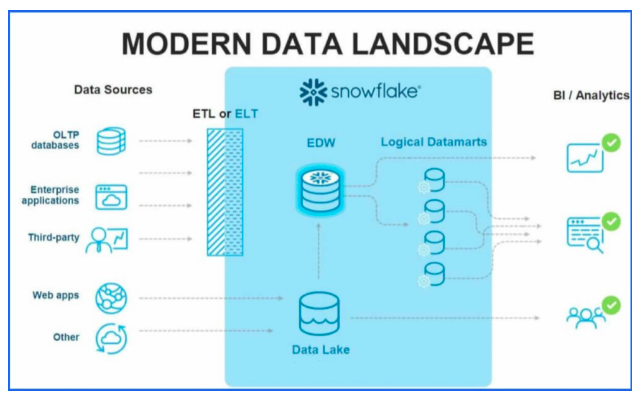
As shown above, Snowflake’s architecture and security features enable integration with third-party tools, ELT/ETL, business intelligence systems, and AI/ML workflows.
Since Snowflake is a cloud-based data warehouse, it is well-suited for ELT processes. In fact, many of Snowflake’s features are designed specifically for ELT.
For example, Snowflake’s micro-partitioning feature automatically partitions data into small, equal-sized pieces. This makes it easier to load and transform data in parallel, which makes the process much faster.
In addition, Snowflake’s “zero-copy clones” feature enables users to create copies of data without actually copying the data. This allows users to experiment with different transformations without worrying about the impact on performance.
Snowflake’s “time travel” feature enables users to view data as if it existed at any time. This can be helpful for troubleshooting issues or auditing data.
So, which is better for Snowflake: ETL or ELT? The answer really depends on the use case. However, many users find that ELT is a better fit for Snowflake because of its cloud infrastructure.
Streamline Data Transformations With DataLakeHouse
DataLakeHouse is a 100% Snowflake-focused end-to-end analytics platform that integrates your most-used sources to Snowflake so you can focus on developing the applications that are important to your business. Simply load data from any source to your destination on the Snowflake Data Cloud and let our platform do the rest.
Our comprehensive suite of data tools and integrations includes:
- ELT Data Ingestion: DataLakeHouse can ingest data from dozens of popular sources—including databases, files, and streaming data—into Snowflake. We also provide pre-built connectors for popular sources like Salesforce, MySQL, Square, HubSpot, Shopify and NetSuite.
- Industry-Specific Pre-Built Models: DataLakeHouse comes with pre-built models for popular industries like eCommerce, healthcare, and financial services. These models can be used to accelerate the development of ELT processes.
- AI/ML-Powered Transformation: DataLakeHouse’s AI/ML-powered transformation engine enables users to quickly and easily transform data into the format required for their applications.
Request a demo today to learn more about how DataLakeHouse can help you develop complex ELT processes.


